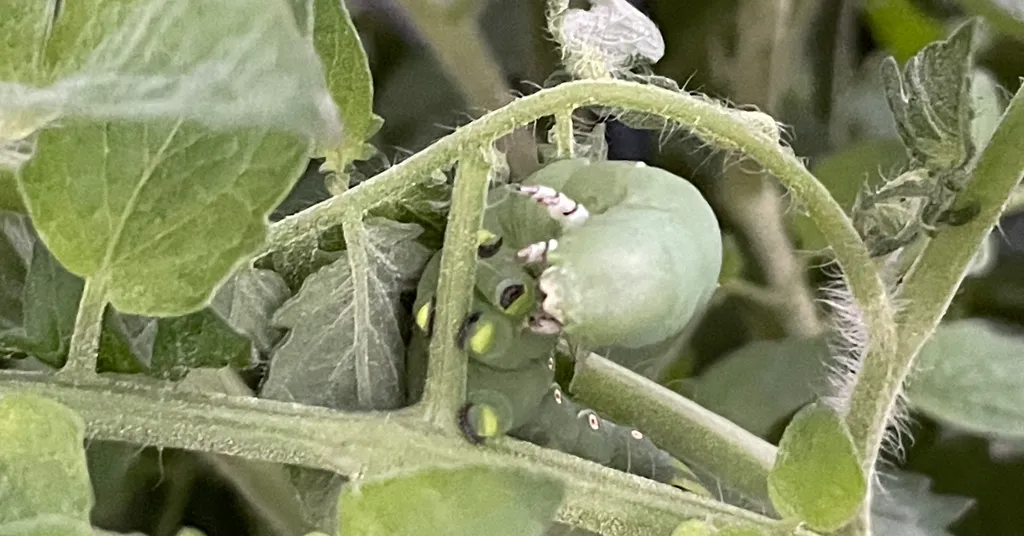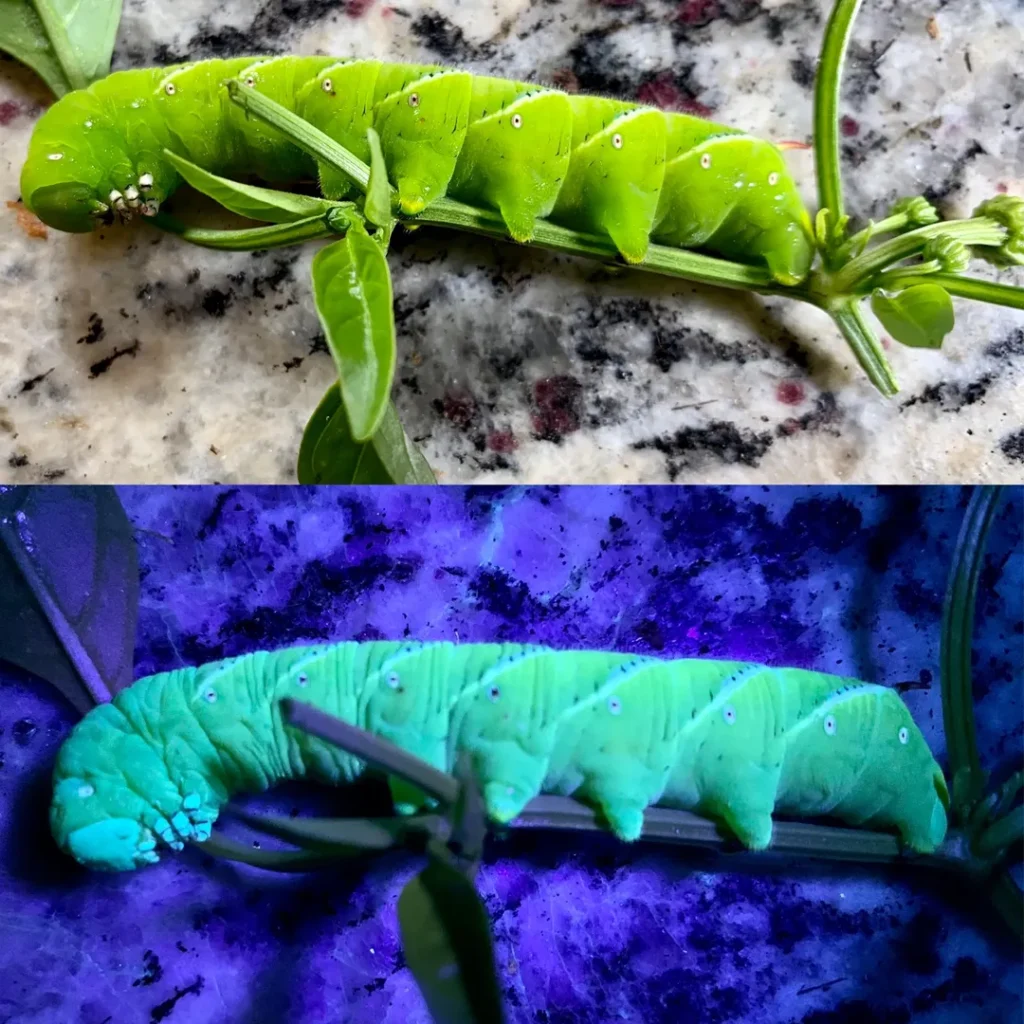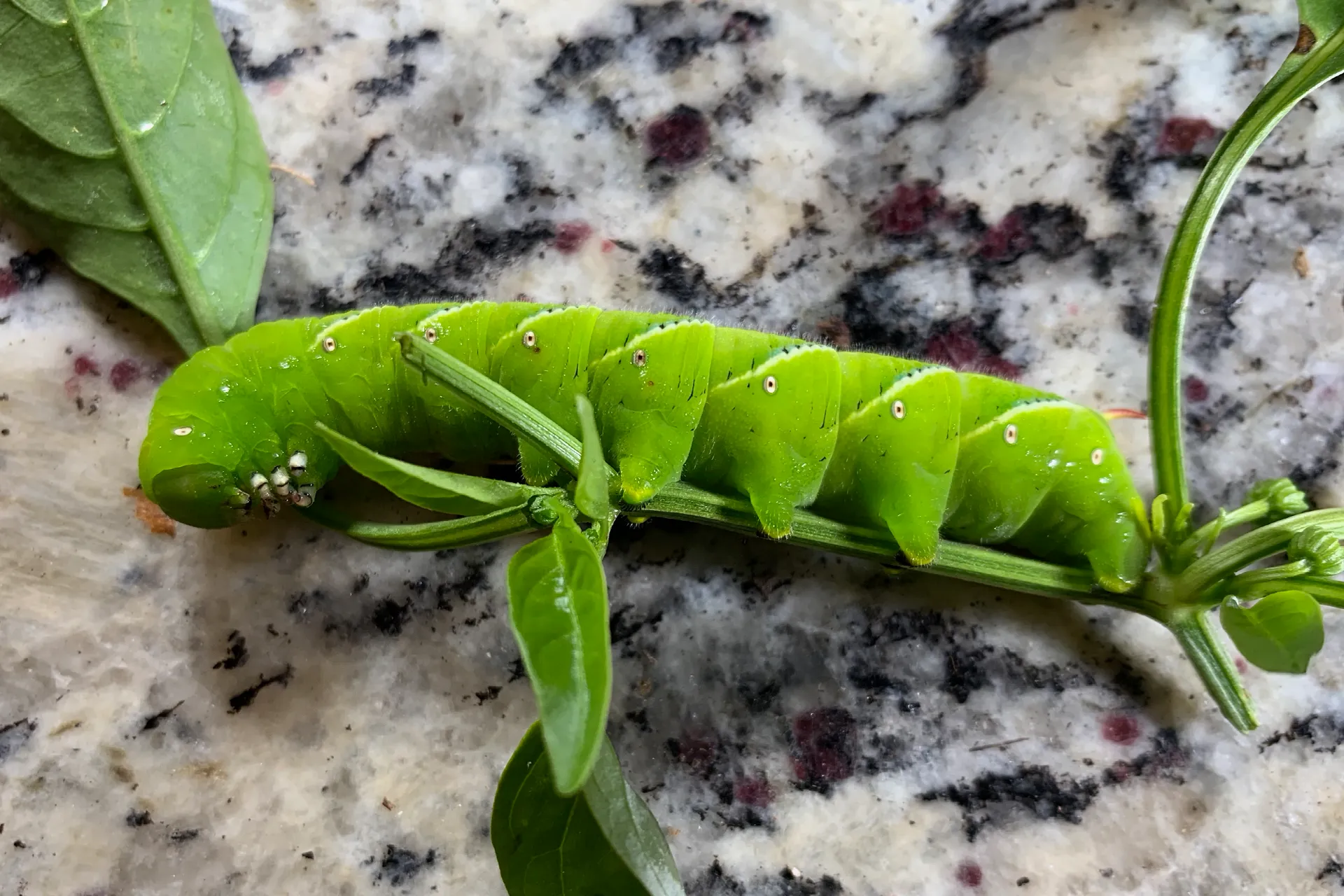This post may contain affiliate links. When you purchase through links on my site, I may earn a commission at no cost to you. See my Privacy Policy for details.
Tomato Hornworms are a common garden pest that can wreak havoc on your tomato plants. These large, green caterpillars have a voracious appetite and can quickly eat all the leaves off a tomato plant. This can cause a significant reduction in fruit production.
Despite their destructive nature, many gardeners have never heard of Tomato Hornworms, or mistake them for other pests. Let’s take a closer look at what Tomato Hornworms are, their life cycle, the damage they cause, and most importantly, how to prevent and control their infestations. That way you’ll have a better understanding of these pesky creatures and how to keep your tomato plants safe from their destruction.
Tomato Hornworms can cause significant damage to tomato plants, leading to a decrease in fruit production and ultimately, lower yields. Ignoring this pest problem can result in a reduced harvest or even the loss of entire tomato plants. If left unchecked, Hornworm infestations can spread quickly to neighboring plants and can be challenging to control once established. Therefore, it is essential to address this pest problem as soon as possible to protect your tomato plants and ensure a healthy harvest.
Identifying Tomato Hornworms
Tomato Hornworms are large, green caterpillars that can grow up to 4 inches in length. They have eight V-shaped stripes on their bodies and a prominent “horn” at the end of their abdomen, which gives them their name. The horn is harmless and does not sting.
Their bodies are covered in small black spots, which are spiracles, or tiny breathing holes. Hornworms have strong jaws that they use to chew on the leaves and stems of tomato plants.
They also have three pairs of legs near the front of their body and several prolegs, which are fleshy leg-like structures located along the abdomen. These prolegs help the Hornworm move and grip onto surfaces. When disturbed, Tomato Hornworms will thrash around violently, making them difficult to handle.
The life cycle of the Tomato Hornworm
The life cycle of the Tomato Hornworm begins when the adult Five-spotted Hawk moth lays its eggs on the leaves of tomato plants. The eggs are small, round, and light green. After a few days, the eggs hatch, and the larvae emerge. The larvae are the Tomato Hornworms, and they will begin to feed on the tomato plant’s leaves and fruit.
As the Hornworms grow, they molt their skin several times, shedding their old skin and growing a new one. Each time they molt, they become larger and more destructive to the tomato plant. The larval stage lasts for 3-4 weeks, during which time the Hornworms can grow up to 4 inches long.
After the larval stage, the Hornworms will burrow into the soil and form a cocoon. Inside the cocoon, they will pupate for 2-4 weeks, during which time they undergo metamorphosis and transform into adult moths.
When the adult Five-spotted Hawk moth emerges from the cocoon, it will mate and lay eggs on the leaves of tomato plants, starting the life cycle over again. The entire life cycle of the Tomato Hornworm, from egg to adult, takes around 4-5 weeks depending on temperature and other environmental factors.
Damage caused by Tomato Hornworms
Tomato Hornworms can cause significant damage to tomato plants, both in terms of growth and fruit production. As the Hornworms feed on the leaves and stems of the plant, they can strip the plant of its foliage and stunt its growth. The loss of leaves can also reduce the plant’s ability to photosynthesize, which can result in a decreased yield of fruit.

In addition to damaging the foliage, Hornworms can also feed on the tomato fruit itself. They will burrow into the fruit, leaving large holes that can quickly spoil the fruit and make it unsuitable for consumption. Even if the fruit is not spoiled, the holes can allow for the entry of disease-causing organisms, further reducing the overall yield of the tomato plant.
If left unchecked, Hornworms can quickly multiply and spread to neighboring plants, causing even more damage. It is essential to address a Hornworm infestation as soon as possible to limit the damage and protect the tomato plants.
Prevention and Control Measures
Tomato Hornworm Prevention:
One of the best ways to prevent Hornworm infestations is to practice good garden hygiene. This includes cleaning up fallen leaves and plant debris, rotating crops, and avoiding planting tomatoes in the same spot each year. You can also use row covers to prevent adult moths from laying eggs on your tomato plants.
Techniques for controlling Hornworms:
Handpicking is an effective way to control Hornworms. Inspect your tomato plants regularly and remove any Hornworms that you find by hand. Did you know that hornworms glow when exposed to black light? My kids love to go in the garden at night with the black light to hunt for hornworms. I prefer to wear gloves when handpicking the hornworms off my plants. They tend to thrash around when you try to pick them off.

You can also use a spray of water to knock the caterpillars off the plant. Another option is to use Bacillus Thuringiensis (BT), a natural bacteria that is toxic to Hornworms but safe for humans and other animals. BT is available in a spray or powder form and should be applied directly to the Hornworms or the leaves of the tomato plant.
Introduction of natural predators:
Several natural predators can help control Hornworm populations. These include parasitic wasps, which lay their eggs inside the Hornworms, and braconid wasps, which also parasitize Hornworms. You can attract these predators to your garden by planting flowers that provide nectar and pollen, such as dill, parsley, and fennel. If you see a hornworm with lots of white oblong eggs sticking off it you can leave them be. They no longer eat your tomato plants and the wasp eggs will hatch and continue the spread of the beneficial predators.
Unfortunately, I find tomato hornworms in my garden every year. Be sure to continue checking for them because they can be sneaky, since they are green they can be hard to find amongst your tomato foliage. If you notice large sections of leaves or stems that have been chewed on you most likely have some hornworm hunting to do. I recommend the black light method.
Some other garden pests that may be affecting your garden:

